According provided by Nikon ED AF-S Nikkor 70-300mm 1: 4.5-5.6G VR IF SWM lens is huge thanks to the store www.fotika.com.uawhere you can find a huge number of different used photographic equipment, including similar lenses.
Nikon ED AF-S Nikkor 70-300mm 1: 4.5-5.6G VR IF SWM (short for Nikon 70-300 VR) is the classic telephoto zoom lens for Nikon FX full-frame cameras. Such zooms are in great demand for a wide range of photographic tasks. In 2006, Nikon 70-300 VR replaced the older model. Nikon ED AF Nikkor 70-300mm 1: 4-5.6D and for some time it was produced along with an add-on lens Nikon AF Nikkor 70-300mm 1: 4-5.6G. At the time of writing this review (summer 2015), the Nikon 70-300 VR is the only manufactured native telephoto lens of its kind. I think the Nikon 70-300 VR is the best option for anyone who does not want to mess with the more expensive and heavy professional class telephoto lenses of the 70 (80) -200 / 2.8.
All Original Similar Nikon FX Telephoto Lenses
Below is a list of all Nikon Nikkor telephoto lenses without high aperture and with auto focus support:
- Nikon AF Nikkor 70-210mm 1: 4, 1986-1987
- Nikon AF Nikkor 70-210mm 1:4-5.6, 1987-1993
- Nikon AF Nikkor 75-300mm 1:4.5-5.6, 1989-1998
- Nikon AF Nikkor 80-200mm 1:4.5-5.6D, 1991-1999
- Nikon AF Nikkor 70-210mm 1:4-5.6D, 1993-2000
- Nikon AF Micro Nikkor 70-180mm 1: 4.5-5.6D ED, 1997-2005
- Nikon AF Nikkor 75-240mm 1:4.5-5.6D, 1999-2000
- Nikon AF Nikkor 70-300mm 1:4-5.6D ED, 1998-2006
- Nikon AF Nikkor 70-300mm 1:4-5.6D, 1998-2006 (?)
- Nikon AF Nikkor 70-300mm 1:4-5.6G, from 2000 to 2014, black or silver
- Nikon AF S Nikkor 70-300mm 1:4.5-5.6G ED VR IF SWM, from 2006 to 2017
- Nikon AF S Nikkor 70-200mm 1: 4G ED SWM VR IF N Nano Crystal Coat, from 2012 to the present day
- Nikon AF-P Nikkor 70-300mm 1:4.5-5.6E VR ED, 2017 to present
The names of the lenses are indicated according to their spelling on the case.
Main technical characteristics of Nikon ED AF-S Nikkor 70-300mm 1: 4.5-5.6G VR IF SWM:
| Review Instance Name | Nikon ED AF-S Nikkor 70-300mm 1: 4.5-5.6G VR IF SWM Ø 67 made in Thailand US2603898 |
| Basic properties |
|
| Front Filter Diameter | 67 mm, plastic thread for filters |
| Focal length | 70-300 mm EGF for Nikon DX cameras is 105-450 mm |
| Zoom ratio | 4.3 x |
| Designed by | for digital cameras Nikon FX |
| Number of aperture blades | 9 rounded petals |
| Tags | focusing distance in meters and feet, focal lengths for 70, 100, 135, 200, 300 mm, bayonet mount mark, hood mount mark, mark for working in the infrared spectrum |
| Diaphragm | 70 mm from F / 4.5 to F / 32. At 300 mm from F / 5.6 to F / 40. The lens does not have an aperture ring (G - lens type) |
| MDF (minimum focusing distance) | 1.5 m over the entire range of focal lengths, maximum magnification ratio 1: 4 |
| The weight | 745 g |
| Optical design | 17 elements in 12 groups. The circuit includes 2 low dispersion element (shown in yellow in the optical diagram). The presence of such elements is indicated on the case with the abbreviation 'ED'. The red frame indicates the lenses included in the stabilizer.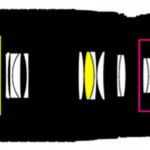 The image of the optical circuit is clickable. The image of the optical circuit is clickable. |
| Lens hood | Nikon HB-36 |
| Manufacturer country | Made in thailand |
| Period | From August 9, 2006 to July 11, 2017. Subsequently replaced by Nikon VR ED AF-P NIKKOR 70-300mm 1: 4.5-5.6E. |
| Instruction (multilingual) | Download, mirror 1 |
| Price |
In 2012, a more advanced model of this telephoto lens came out - Nikon N AF-S Nikkor 70-200mm 1: 4G ED SWM VR IF Nano Crystal Coat.
Assembly
All Nikon 70-300 VR lenses come from Thailand. To the touch the lens is quite pleasant and weighty, its weight is a little more than 700 grams. On cameras Nikon D700 и Fujifilm FinePix S5 Pro its weight does not cause any discomfort.
Nikon 70-300 VR uses 67 mm standard filters. The zoom ring is very wide, rubberized and comfortable, it’s much more convenient to rotate it than, say, the model Nikon 28-300mm 1: 3.5-5.6G VR... The focusing ring is plastic. Nikon 70-300 VR has metal bayonet mount. Almost the entire outer rim of the case is made of plastic. The retractable frame of the case consists of one section and is quite durable to the touch. As for the amateur lens, the Nikon 70-300 VR has good build quality. At one time, I used the Nikon 70-300 VR for a year, and at the same time, the lens did not begin to suffer from the spontaneous extension of its trunk.
There is a mark on the case for quick installation of the hood. The lens uses a plastic hood HB-36, which is fixed in special grooves located near the front lens of the lens. The hood can be installed in the opposite direction for transportation. In this position, it is somewhat inconvenient to use the zoom. While changing the focal length, the lens hood moves with the trunk of the lens.
On the bayonet side, the lens has a special rubber gasket, which serves to protect the lens from dust and moisture. On official sources, accurate confirmation that the Nikon 70-300 VR is a dustproof and waterproof lens cannot be found. At the same time, I am inclined to believe that because of this rubber seal, the lens still has at least some basic dust protection.
When changing the focal length, the rear lens moves in the middle of the lens body like a pump - it draws in and pushes out air. This behavior of the rear lens is called 'vacuum cleaner effect', which can increase the amount of dust that accumulates in the camera. It is funny that when zooming from 70 to 100 mm, the rear lens does not move, the movement occurs only in the range from 100 to 300 mm.
Diaphragm
Diaphragm lens consists of 9 rounded petalsthat form a smooth hole. The aperture range is available from F / 4.5-5.6 to F / 32-F / 40. Unfortunately, compared to the previous version of the lens - Nikon ED AF Nikkor 70-300mm 1: 4-5.6D, the new Nikon 70-300 VR has lost some of its aperture and now uses F / 4.5 instead of F / 4, which is about 1.27 less.
There are marks with a focal length on the zoom ring, the following is a list with the minimum numbers F available for these marks:
- 70 mm - F / 4.5
- 100 mm - F / 4.5
- 135 mm - F / 4.8
- 200 mm - F / 5.3
- 300 mm - F / 5.6
Stabilizer
The Nikon 70-300 VR has a VR stabilizer (Vibration Reduction), which according to the instructions can compensate up to 4 stops by shutter speed. In numerical terms, this means that you can shoot at shutter speeds 16 times longer than what a lens without a stabilizer requires. The stabilization system of the Nikon 70-300 VR refers to second generation (VR II).
The instructions for the Nikon 70-300 VR lens indicate 4 stops (Nikon measurements), and on the official website only 2.5 stops (measured by CIPA). In any case, the stabilizer works well.
To enable / disable the stabilizer on the lens there 'VR ON / OFF' switch. There is a 'Normal / Active' switch to select a mode. The stabilizer can operate in two modes: 'Normal' and 'Active'.
- 'Normal' mode designed for most scenes and avoids movement when camera shake. Theoretically, the 'Normal' mode can still track the movement of the camera to create panoramas.
- Active Mode most suitable for shooting when the camera can not only shake, but also move in different directions. Most often, it is advised to use this mode when shooting in motion.
I managed to take pictures of stationary objects, without blur and hard work, at 300 mm focal length and 1/40 second. The stabilizer works well, but it does not compare with the stabilizer in newer models, such as Nikon 70-200 / 4G.
When the stabilizer is working, the image in the viewfinder can jerk, this is due to the methodology of the vibration reduction system, which tries to keep the picture without stirring, but when the lens deviates greatly from the 'target', the stabilizer abruptly switches to a new scene. During its operation, the stabilizer creates a barely audible hum.
Focusing
Nikon 70-300 VR focuses quietly enough thanks to 'SWM'-motor (Silent Wbird Motor - quiet wave motor) and refers to the lens'AF S'type (with built-in motor focusing), and therefore it will automatically focus on any Nikon digital SLR camera.
The minimum focusing distance is 1.5 meters, while you can shoot Macro with 1: 4.5 magnification. Nikon Nikon 70-300 VR has a window with a scale of distances in meters and feet. There is no IPIG scale, but there is a mark for 70 mm focal length for working in the infrared spectrum. In the instructions, you can find deviations during photography in the infrared spectrum and for other values of the focal length.
Nikon 70-300 VR focuses fast. Focusing speed does not cause any complaints, although inferior to more expensive lenses. On cameras Nikon D700 and and Fujifilm FinePix S5 Pro the lens focuses tenaciously (does not lose objects from the zone of sharpness). Only sometimes, at 300 mm of focal length, the lens and camera try to refocus.
During focusing, the front and rear lenses remain stationary, as the lens uses internal focusthat is indicated on the case by the letters'IF'-'Iinternal Focus' - 'Inner Focus'. During zooming, the front lens leans forward but does not rotate. Thus, it is possible to use any filters without problems, for example polarizing or gradient.
On the lens housing you can find focus switch 'M / A - M'. In the 'M / A' position, auto focus works with constant manual focus priority. The 'M / A' mode is very convenient and useful - for manual focusing or focus correction, you do not need to additionally switch the lens to the 'M' mode. As soon as you start focusing manually using the 'M / A' mode, the auto focus is immediately turned off, and the lens continues to listen to your hands until you press the focus activation button again.
The focus ring rotates to 180 degreesManual focus is easy.
Nikon 70-300 VR suffers greatly from the 'Focus Breathing' effect - changing the viewing angle when focusing.
Compatibility and Features
The lens will work correctly at all Nikon digital SLR cameras.
When using the built-in flash, especially with the lens hood installed, photos may have a black shadow.
EGF lens for Nikon DX cameras is 105-450mm. An analogue of the Nikon 70-300 VR for Nikon DX cameras can be considered Nikon DX AF-S Nikkor 55-200mm 1: 4-5.6G ED VR IF SWM and Nikon DX AF-S Nikkor 55-200mm 1: 4-5.6G ED VR II. This Nikon 70-300 VR works wonderfully on cropped cameras and does not cause much inconvenience due to recalculation EGF. In the case of telephoto lenses crop factor Nikon DX cameras in most cases only benefit.
A list of all Nikon DX series lenses can be found. here. The optical design of all Nikon DX lenses can be viewed here.
Who should use such a lens?
The lens is suitable for everyone to shoot from afar. Due to the fact that the Nikon 70-300 VR is weak aperture, you can shoot moving objects only in good light. The stabilizer does not help when shooting moving objects, it only compensates for the jitter and movement of the camera and lens. With the Nikon 70-300 VR, you can easily capture wildlife. The lens is suitable for anyone who needs a good telephoto lens.
If you need an even longer telephoto lens, you can look at an old, but not very expensive Nikon ED AF VR-Nikkor 80-400mm 1: 4.5-5.6D Vibration Reduction.
Image quality
In general, the Nikon 70-300 VR creates a pretty high-quality picture.
On open apertures, the lens is sharp in the center in the range of 70-200 mm, in the range of 200-300 mm, the sharpness is slightly worse. Also noticeable drop in sharpness at the corners and edges. If you cover the aperture, the sharpness becomes a level higher.
Chromatic aberrations well fixed. Also, the freezing is well corrected (the color of the contrast zones of blur in green and purple). Visually, in real photos, distortion it’s hard to notice, at the same time, the Nikon 70-300 VR is still small distortion there is. The lens behaves well in side and backlight, which is not surprising for a dark zoom lens
Nikon 70-300 VR blurs the background well when shooting portraits and has a nice hips. Boke even on covered diaphragms it remains quite pleasant.
You can download RAW source files at this link (26 files in the '.RAF' format, 354 MB). All photos are on-camera JPEG. All photos were shot on Fujifilm FinePix S5 Pro without using a hood.
My experience
I tried all the native budget autofocus telephoto lenses for full-size cameras (everything except Nikon AF Nikkor 75-240mm 1: 4.5-5.6D) and I think that the Nikon 70-300 VR is the best among them, although it costs much more than its brothers without an image stabilizer .
If there is no money for the Nikon 70-300 VR, then among the low-end counterparts deserves due attention Nikon ED AF Nikkor 70-300mm 1: 4-5.6D и Tamron LD DI AF 70-300mm 1: 4-5.6 Tele-Macro (1: 2)as well as a good but more expensive Tamron DI SP 70-300mm F / 4-5.6 VC USD A005NII.
Prices
Real prices for Nikon ED AF-S Nikkor 70-300mm 1: 4.5-5.6G VR IF SWM lens see here, or in the price block below:
All 70-300 Class Full Frame Lenses with Stabilizer
Sigma
- Sigma DG OS 70-300mm 1: 4-5.6 (for Sigma SA, Sony A, Nikon F, Pentax K, Canon EF / EF-S)
Tamron
- Tamron DI SP 70-300mm F / 4-5.6 VC USD A005 (for Nikon F, Canon EF / EF-S, Sony A)
Canon (EF, EF-S)
- Canon Zoom Lens EF 75-300mm 1: 4-5.6 IS USM
- Canon Zoom Lens EF 70-300mm 1: 4-5.6 IS USM
- Canon Zoom Lens EF 70-300mm 1: 4-5.6 IS II USM (NanoUSM)
- Canon Zoom Lens EF 70-300mm 1: 4.5-5.6 DO IS USM
- Canon Zoom Lens EF 70-300mm 1: 4-5.6 L IS USM
Nikon (F, FX)
Sony (E, FE)
The names of the lenses are indicated according to the inscription on their body.
Comments on this post do not require registration. Anyone can leave a comment. Many different photographic equipment can be found on AliExpress.
And a few more examples for the full frame:
All shot on Nikon ED AF-S Nikkor 70-300mm 1: 4.5-5.6G VR IF SWM. Photos in the gallery without processing.
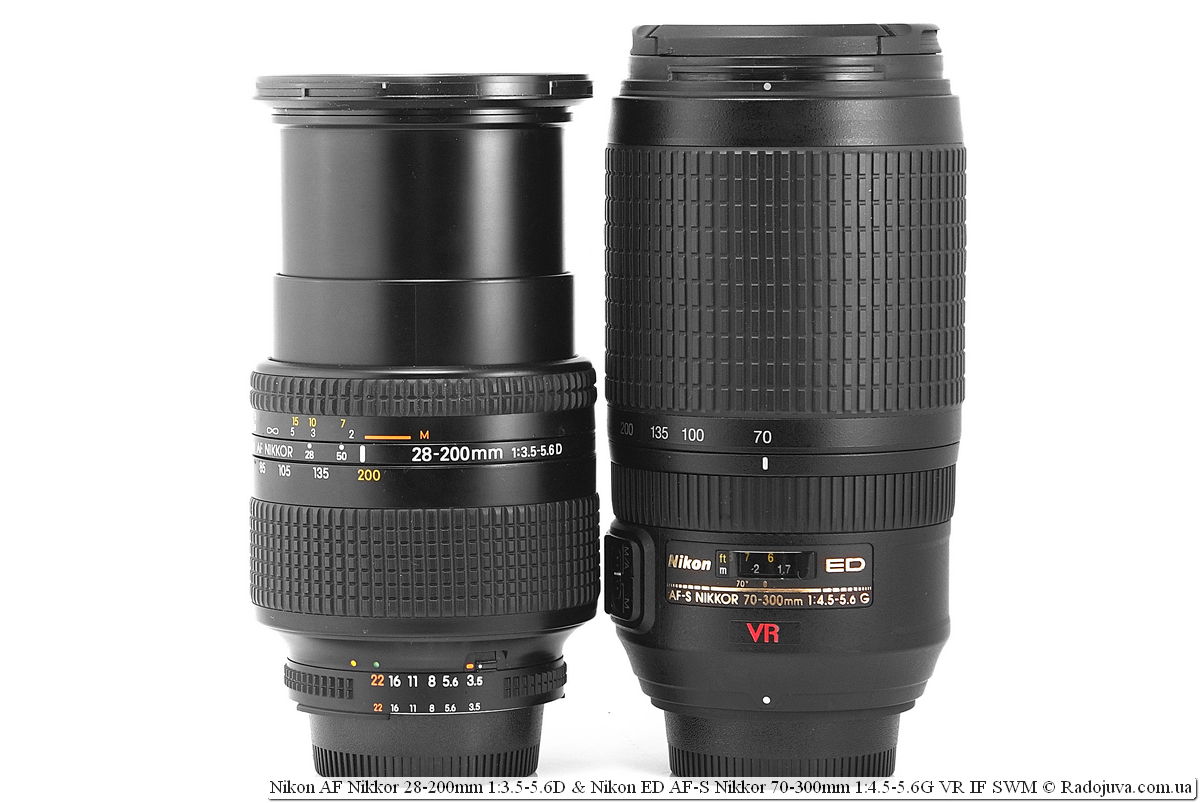
dimensions Nikon AF Nikkor 28-200mm 1: 3.5-5.6D and Nikon ED AF-S Nikkor 70-300mm 1: 4.5-5.6G VR IF SWM
Results
Nikon 70-300 VR is a good telephoto lens, the best of its kind. Perfect for Nikon FX and Nikon DX cameras.
UPDATE: On July 11, 2017, a replacement for this lens was introduced in the face Nikon VR ED AF-P NIKKOR 70-300mm 1: 4.5-5.6E.
Material prepared Arkady Shapoval. Training/Consultations | Youtube | Facebook | Instagram | Twitter | Telegram

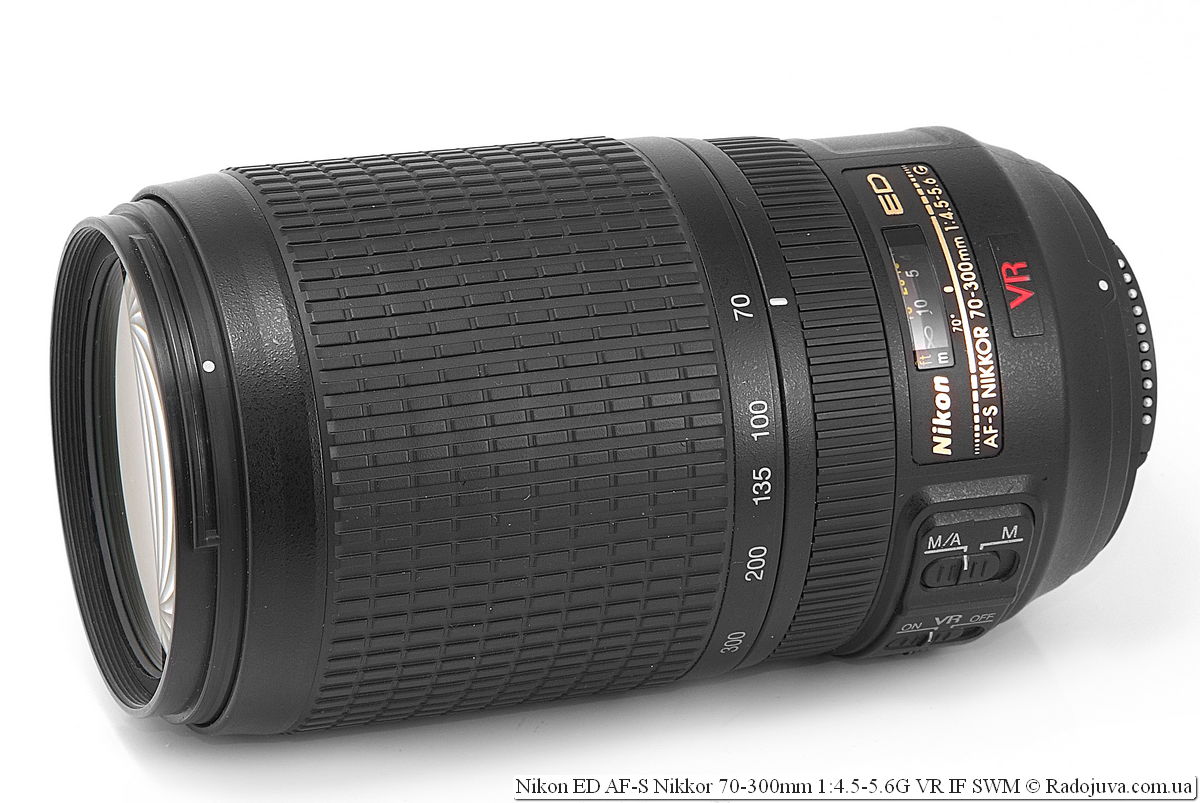
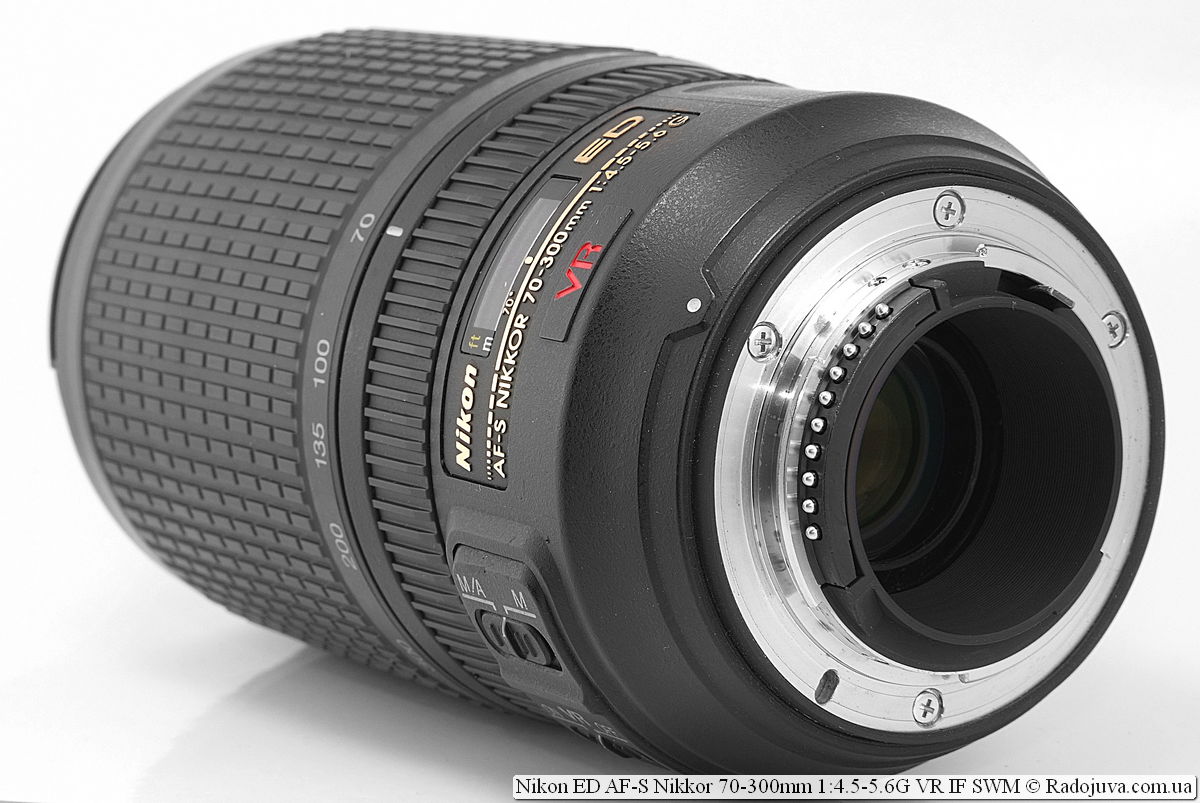
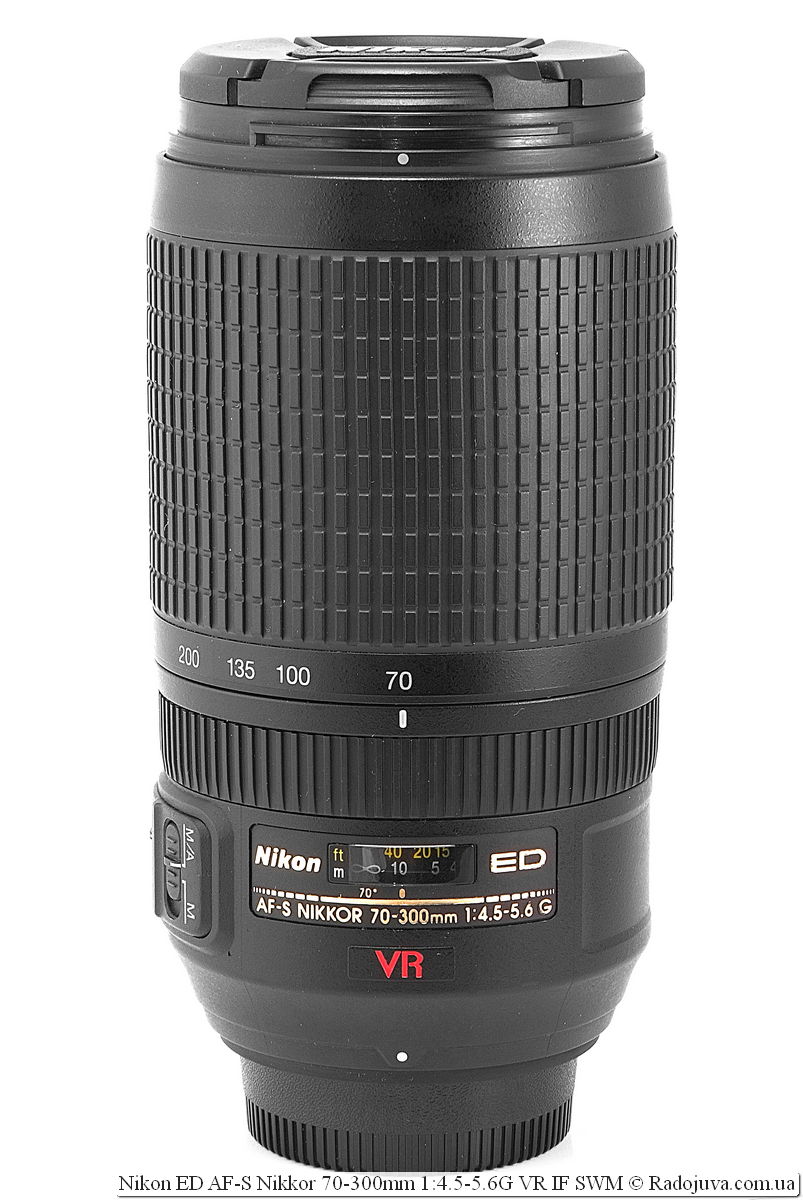
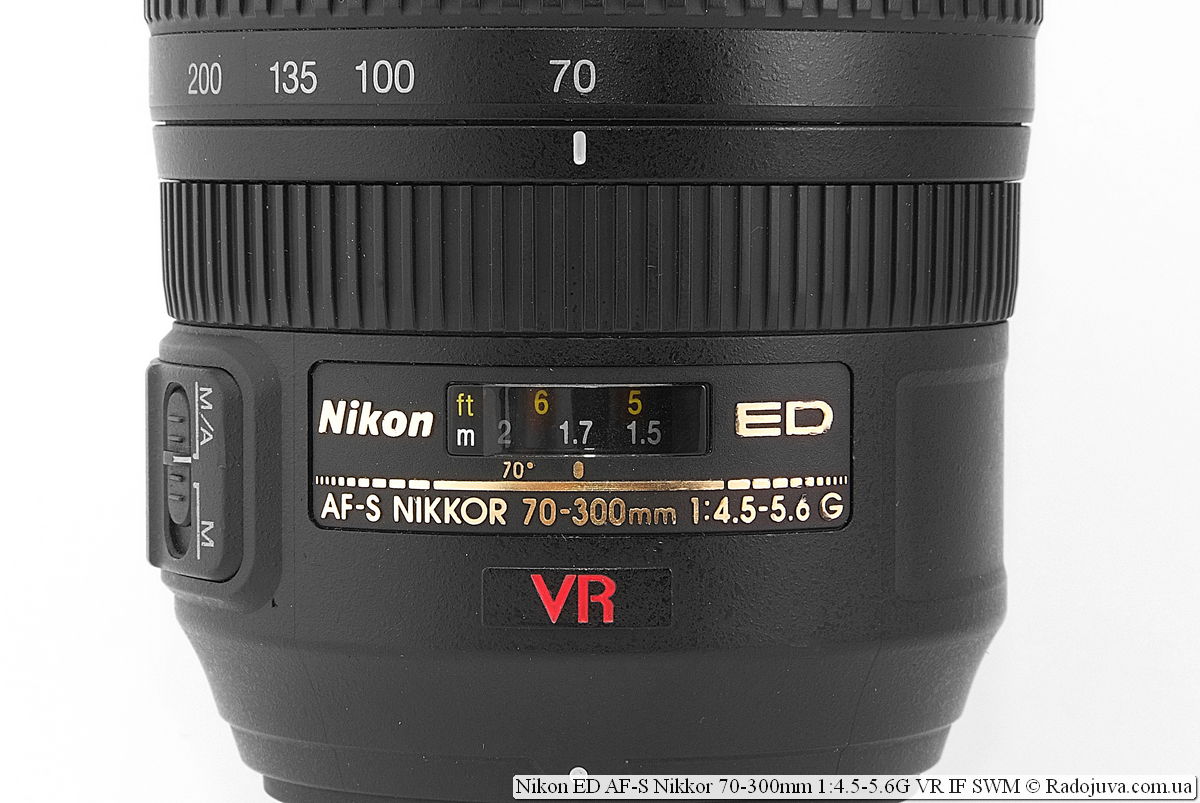
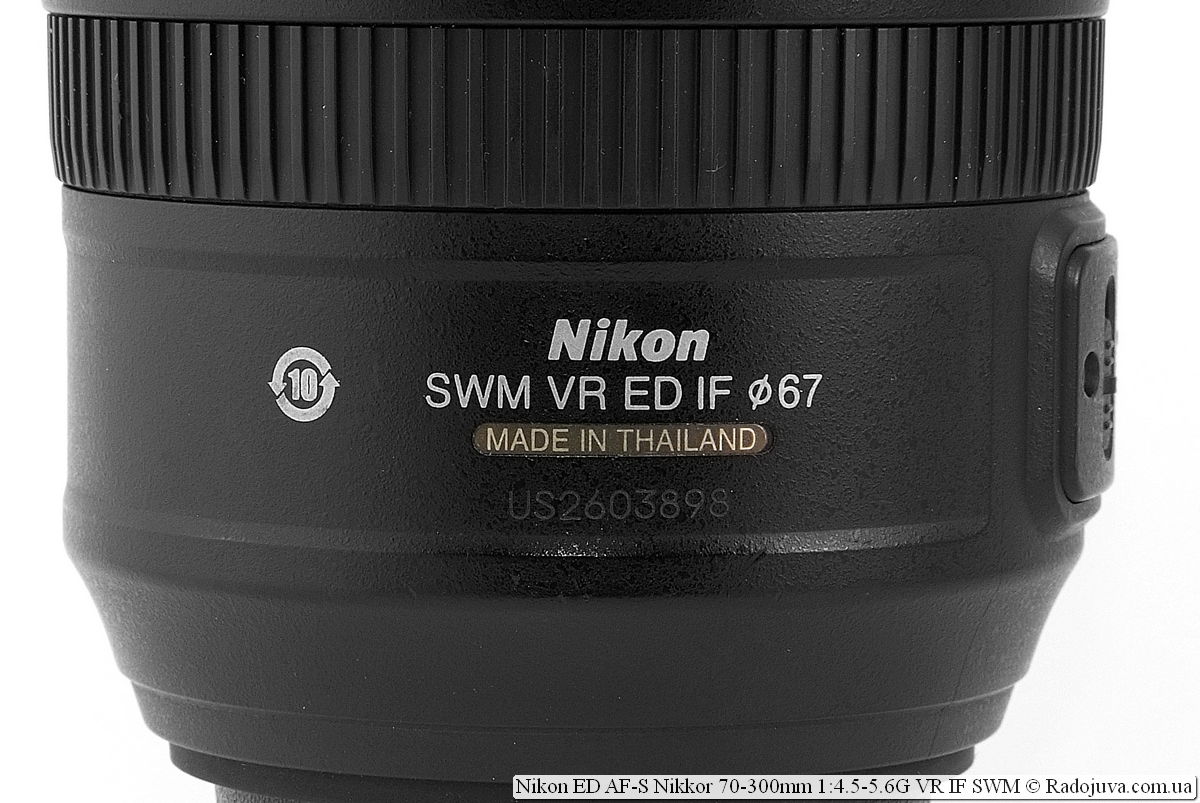
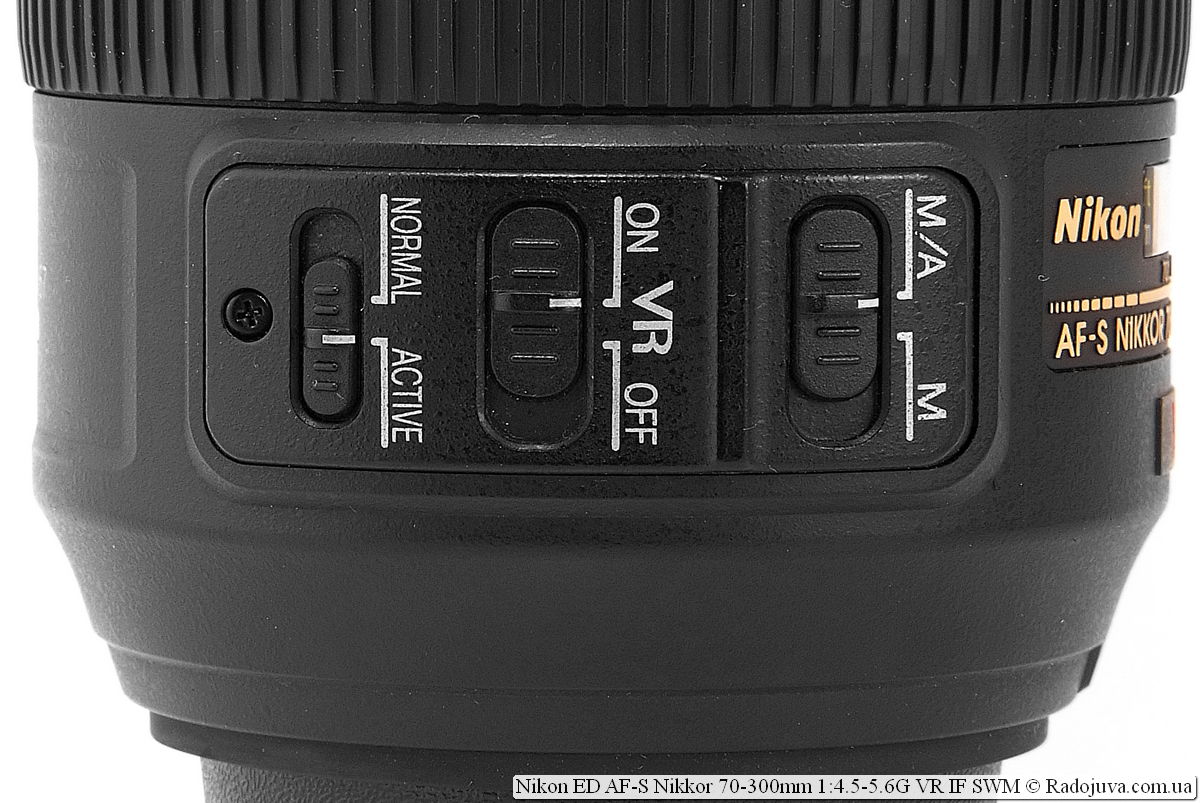
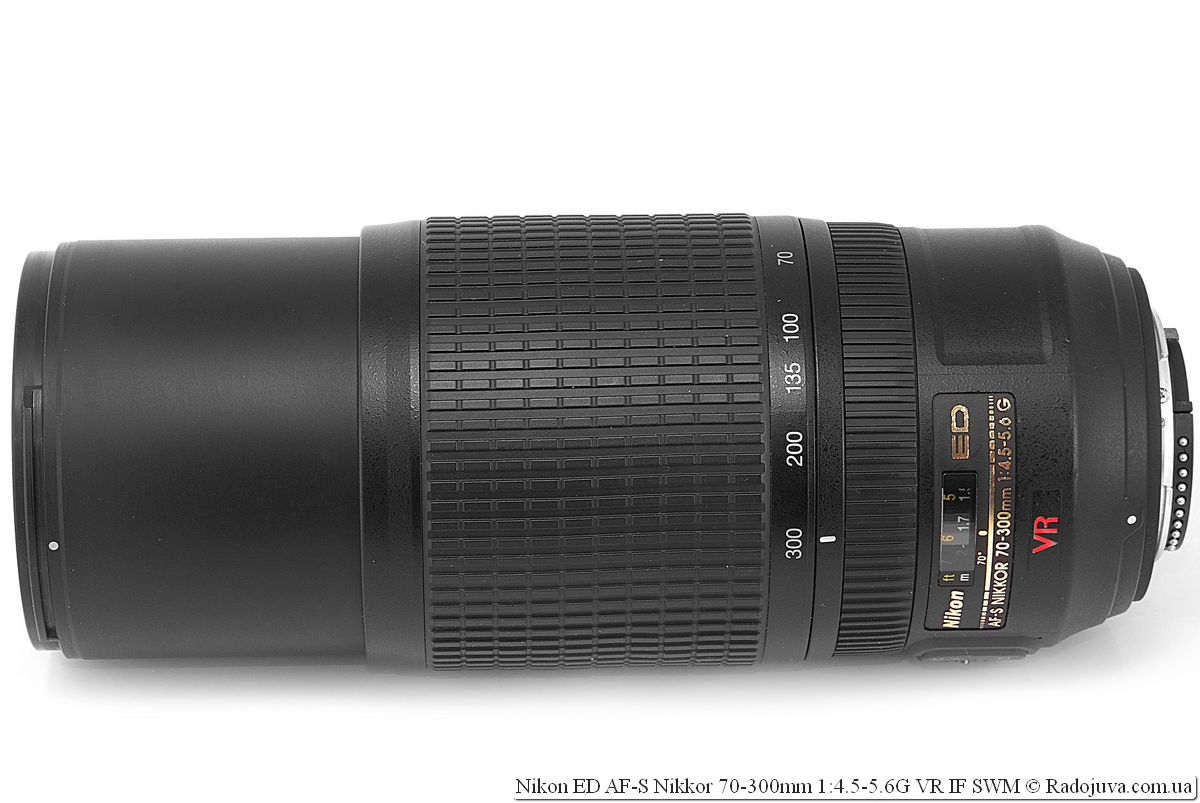
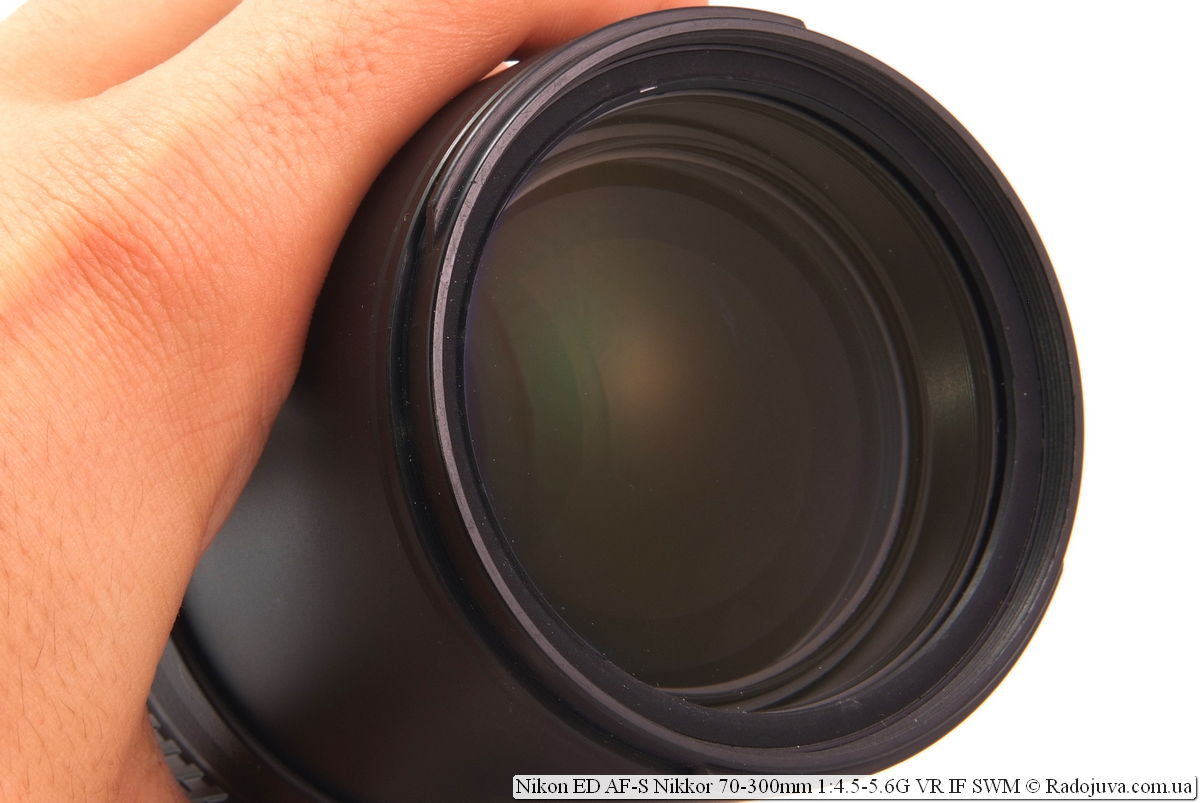
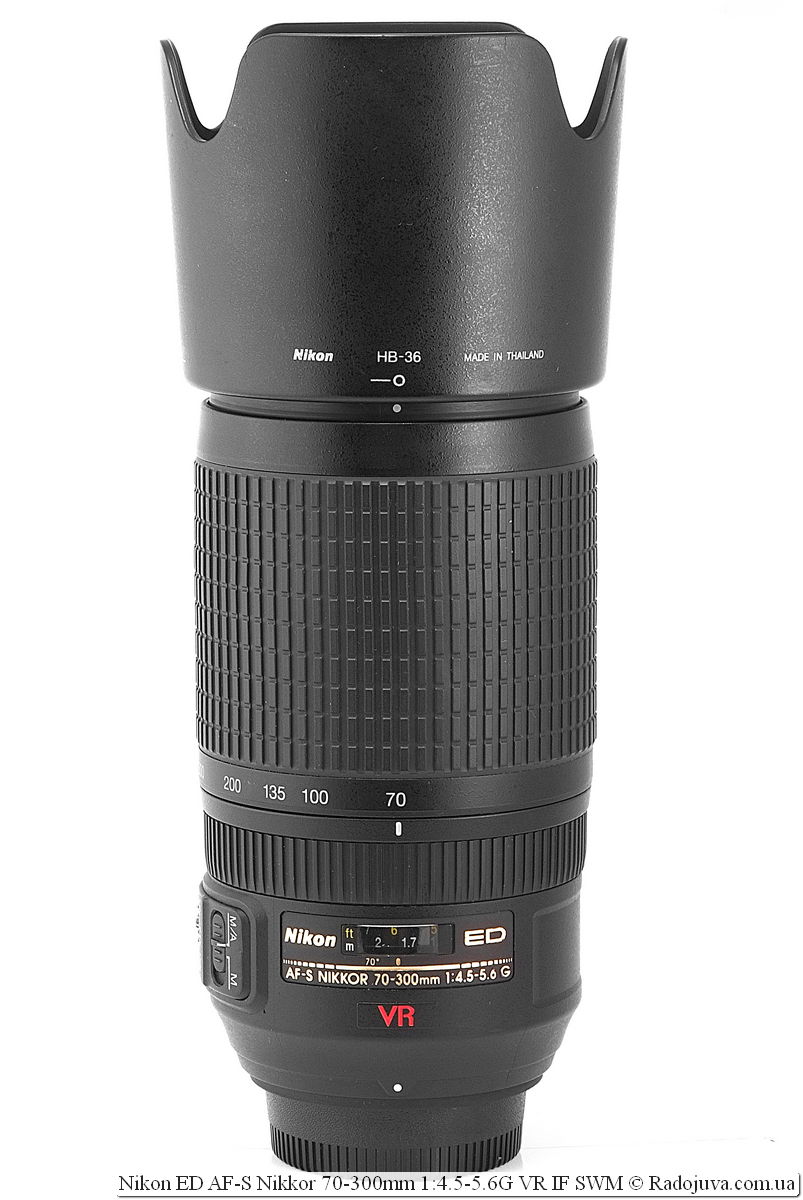
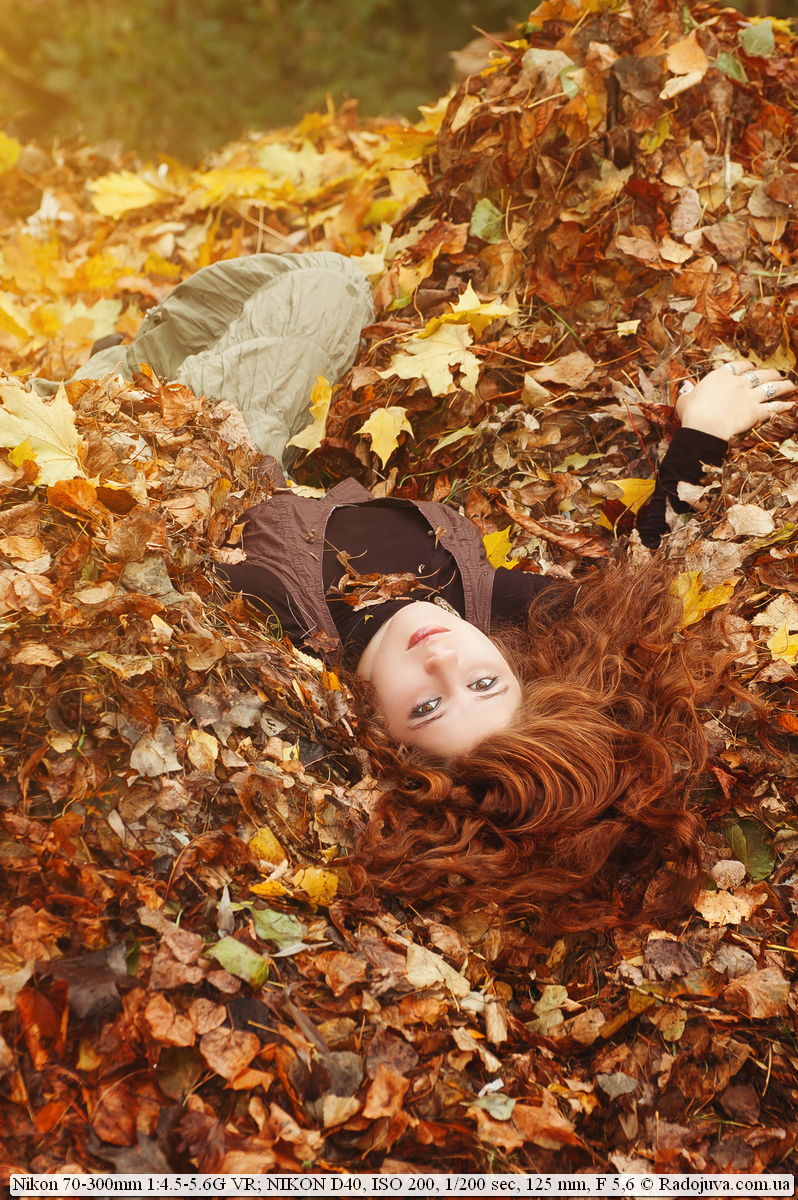

























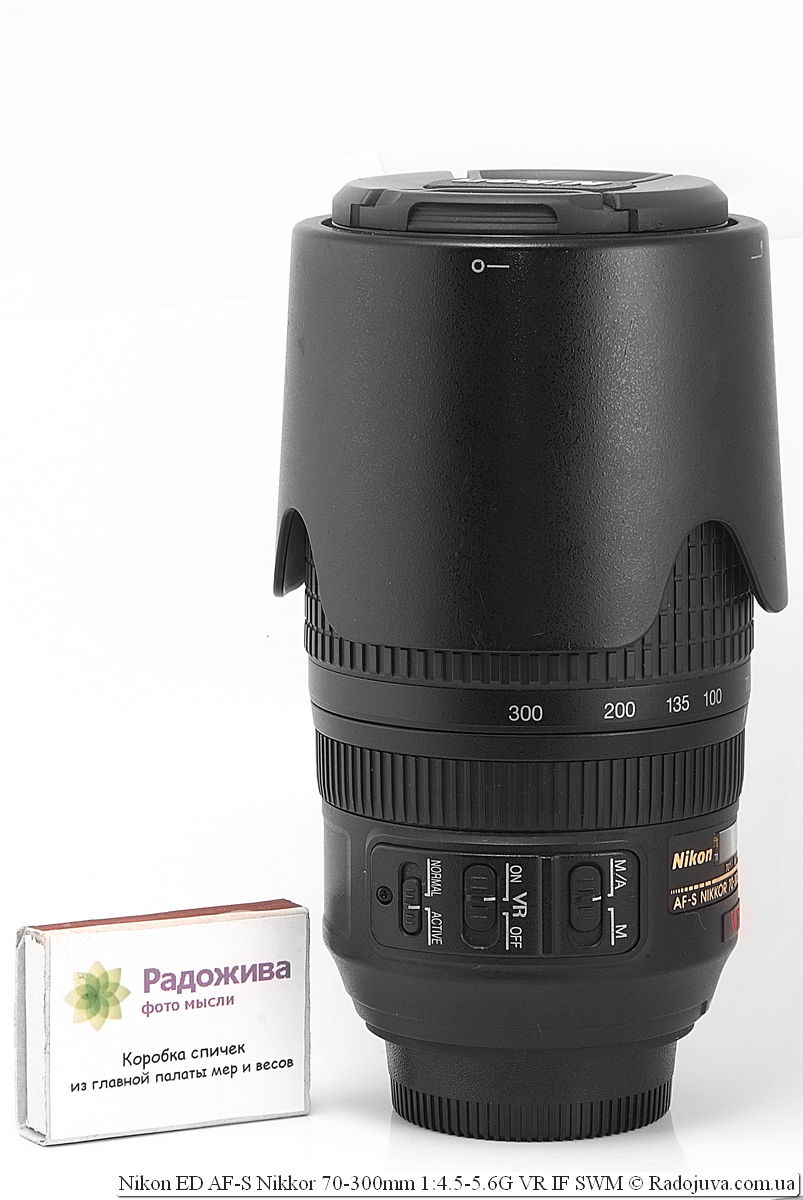
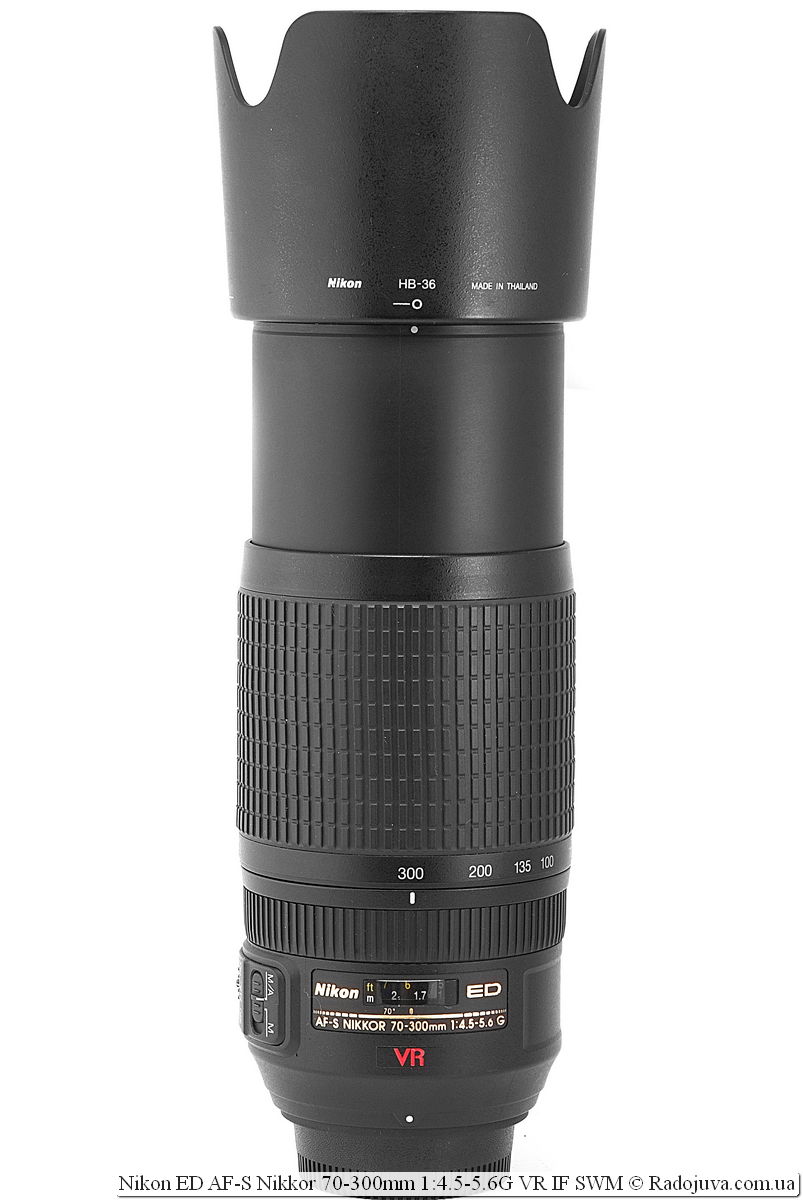
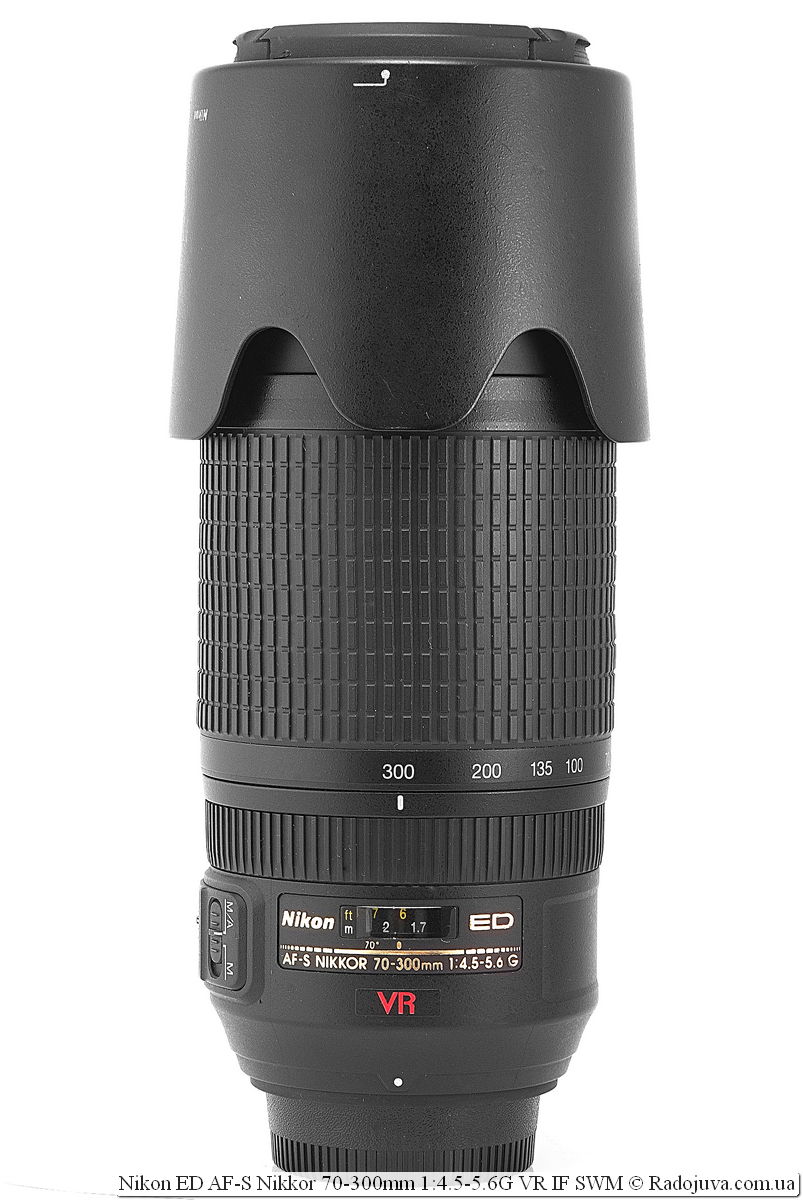
















Thanks for the answer. By the way, have you already sold it? And why did they use little?
Yes, I did. On the crop it is a bit dark and too long, on the full frame I use 85 points more.
It's a pity ... You had a good price. And I would be sure of the quality.
Hello! Interested in the choice of telephoto (wide angle is not important) on the d90. 3 options are considered.
1 Nikkor AF 70-300mm f / 4-5.6G
2 Tamron AF 70-300mm F / 4-5,6 Di LD Macro for Nikon
3 Nikkor DX 55-300mm f / 4.5-5.6G ED VR AF-S
the first two are interesting for their price. Is it worth it?
How does the 1st differ from the one considered in the article, except for the stub and motor? Is everything else the same?
And yet, will a lens with a motor focus faster than without it?
Thank you!
There is another optical design, image quality, focus method.
The focusing speed depends on the lens models, in this case the lens from this review will outperform the Nikkor AF 70-300mm f / 4-5.6G
Arkady, good afternoon! Please tell me what is still better than 70-300 VR or 55-300VR? The price difference is palpable! Purpose: just take pictures, use it to the maximum! Which is better in picture, quality?
Thank you!
I did not use 55-300, but I consider 70-300 to be a more successful instance.
I’ve been using this lens for more than 2 years and, unfortunately, I can’t say that everything is as rosy as you wrote. Auto focus is not so fast, especially at the narrow end. Maybe because of the camera (D-50). at the same narrow end, I also expected the best, and the stabilizer seems to be soaping instead of sharper. I have often taken a picture without him and it turns out sharper. I don’t know, maybe I’m doing something wrong. I use it, I agree, it’s very possible. On its wide very sharp, portraits are good are, and people are not so difficult when under the noses of them krutishsya and otoshol meters 3-4 and scholkaesh.
Little depends on the camera, I shot (there is in the review) and on the D40 (with the same matrix from the D50), the quality was up to par.
Everything can be. Maybe I just expected more from him, and expectations were not fully met, therefore there is some unpleasant aftertaste. I photographed the birds on the spring. The spring was in the shade, but the sun was shining through the foliage and, as for me, the light should be enough, but the lens I thought otherwise. ISO is higher than 400 on my camera, it’s a crime. It probably turned out that the general impression of it was spoiled, and in principle the lens is not bad, especially considering its price (I took about $ 550). Probably what I wanted to get it costs around $ 2000, but this is for Enja expensive.
The stabilizer can be washed if removed from a tripod. I also read somewhere (I couldn’t find it now) that the stub needed some time after focusing. If you immediately press the descent, it turns out that the photos with it are more soapy. By the way, Arkady, you, I don’t seem to have seen this information, maybe light it up (regarding the stub).
In general, there is https://radojuva.com.ua/2010/11/vr-vibration-reduce/
I meant the delay in the stabilizer and the stabilizer with a tripod.
I tried to find information about the delay to turn on the stabilizer on the Nikon website, but found only this
https://nikoneurope-ru.custhelp.com/app/answers/detail/a_id/25667
But somewhere I read for sure that the stub can interfere if it is not given time to “stabilize”. I noticed it because I somehow took a photo with a fairly short shutter speed and the photo turned out to be blurry due to movement, not focus miss.
Maybe you have bright thoughts about this, as well as an interesting topic about panning with a stabilizer.
And yet, about the staffer, nikor 18-55, I really have no stabilizer, but if the picture quality differs from the nikor 70-300 VR, it’s not so much. But again, this is on my D-50, as on Other devices will be, I do not know.
At the expense of reviews and articles, this is good and I consider it necessary. I think it is useful not only for beginners, a fresh look from the outside, especially if it is constructive, has not bothered anyone. IMHO. Thank you.
I apologize for the offtopic. There are many questions about the Sigma 70-300 APO DG Macro. With great pleasure I would give it to a professional Arkady, but I'm too far away .. If anyone is interested, there are a dozen of my photos here https://picasaweb.google.com/100039784595379631925/NikonD5100SigmaAPODG
This is literally the first test run with a lens in the vicinity, more until there was time to approach the issue more carefully. The only drawback is the lack of a stabilizer, although in conditions of good light and with a short shutter speed, it is not even necessary for 300 mm. I’m shooting with the D5100. The lens was bought with a hands-on practical new for $ 100))
Thanks for the useful information.
Firstly, I want to thank you for your work, I read your reviews of photographic equipment with great pleasure, everything is simple and accessible. I also want to ask, I choose between this lens and Sigma 150-500, for shooting birds, squirrels and other animals. Which one would you advise if you heard that quality “walks” in sigma?
Sigma has a more interesting focal point, if there were money, then I would take Sigma.
Which lens is better than Nikon 70-300mm f / 4-5.6G Zoom-Nikkor or Review Nikon 70-210mm f / 4 AF. and which one is more expensive ??
70-300 is longer, better for some things, and 70-210 has a constant aperture. 70-210 not available
and if you buy used? which one is better?))
It depends on which camera, because the 70-210 does not have a motor.
for nikon d90))
For the D90, because of the beautiful pattern, I would look for 70-210
thank you))
Do you advise to buy 70-210?)
Yes, coming out of the considerations that I indicated above.
Which lens is better than Nikon 18-105mm f / 3.5-5.6G ED VR AF-S DX Nikkor, Nikon 70-300mm f 4.5-5.6G IF-ED AF-S VR Zoom-Nikkor or Nikon 50mm f / 1.8G AF-S Nikkor
Nikon 18-105mm f / 3.5-5.6G ED VR AF-S DX Nikkor is better for versatility
Nikon 70-300mm f 4.5-5.6G IF-ED AF-S VR Zoom-Nikkor for shooting remote objects, birds and so on
Nikon 50mm f / 1.8G AF-S Nikkor for shooting in low light, portraits, etc.
What is the difference between Nikon 18-105mm f / 3.5-5.6G ED VR AF-S DX Nikkor from AMRON AF 18-200 mm f / 3.5-6.3 XR Di II LD Aspherical (IF) Macro
Zooms in twice as much, in more detail about the focal length here - https://radojuva.com.ua/2012/10/lens-mm/
Do you think tamron is better?)) For nikon d90
In general, yes.
Tell me please! nikon 3100; lens nikon af-s nikor70-300mm 1: 4.5-5.6g is suitable for shooting dog shows.
PU
I’ll leave my 5 cents for budget televisions.
Initially, I took a D3000 camera with a Tamron AF 70-300mm F / 4-5.6 LD 1: 2 Macro telephoto lens, everything was fine, but the focus is slow and there is a lot of chromaticity. The picture is quite bright and the light transmission is simply amazing (as it turned out later after Nikon 55-300). But there was an opportunity to change it to 55-300. I changed it, I was happy as an elephant. But the picture became different, as if you were shooting through a filter (I don't apply filters at all). The picture has become grayish, but sharper and focuses faster. Worked from 55-300 months 6 and sold. Even a tamron with a motorized focus, I liked the picture better. I bought Tamron again but different: Tamron SP 70-300mm f / 4-5.6 Di VC USD. While I was waiting for him from the States, I took from a friend Nikon 70-300 4.5-5.6G IF-ED AF-S VR. It focuses quickly, but the picture is the same as that of the 55-300, a bit dark. I waited for the New Tamron and was greatly surprised by its capabilities! It focuses almost silently, smears very rarely, the picture is juicy and sharp, there is more light than in a similar Nikon 70-300, which makes the picture more pleasant. Sharp at both the long and short ends. I only disliked the sound of the stabilizer, when the stabilization “releases”, a small click appears with a crackling sound. But after reading the description, he calmed down, because this is the norm for him. Stub holds 4-5 stops without problems. I shot it off my hands for 1/6 sec. without lubrication. Even visually you can see how he “holds” the frame.
Compared to the Nikon 70-300 4.5-5.6G IF-ED AF-S VR, Tamron seemed better in my opinion. Now I work with him on the D7000. Very satisfied. I recommend as a budget telephoto.
Tell me, too, Nikon D7000 which of the telly 55-300 and 70-300 will be better or 55-200, the budget is up to 10 000.
the best will be 70-300, from this review, for the amount you indicated - only used (now the price of a new one is about 12000 UAH)
PS I have been looking at prices for a long time, 70-300VR is in online stores from 9600 UAH (~ from $ 410)
Well, not in the know in hryvnia, we can buy for 15 thousand rubles ...
Good afternoon! Thanks for your reviews, I learn a lot. I am the owner of Tokina-50-135mm f / 2.8. I want to take myself a landscape painter or a telephoto. Interested in Nikon 70-300mm f 4.5-5.6G IF-ED AF-S VR Zoom-Nikkor. Please tell me, if you compare this Tokin and Nikon at about the same focal lengths, will there be a big difference? And how on the build quality are the differences between these lenses? Thank.
Hello. Please tell me how you like this lens for shooting figure skating indoors. There is not much light. The distances are decent. The budget is very limited. If there are options, I will gladly accept. Thank.
Nowhere can I find a detailed description (not technical) about the Nikkor 75-300 / 4,5-5,6 lens. Can you tell me? You yourself do not plan to write and tell about him? I think it will be interesting to many to know. Sincerely, Alexander
Arkady, I can’t resist and will also express to you my admiration for your offspring.
I have a somewhat strange question for you about the lens under discussion.
Because there was no opportunity to fully try this lens with my device (D7000) in various conditions, it was limited to the pavilion of the store.
I liked everything in this lens, the tactile sensations from it, the mechanics, the work on the carcass, etc.
But when he got home, he looked at the pictures in full resolution, surprised them with a very strange effect.
And this effect was somewhat upsetting. I do not set a direct goal to use the lens as a macro, but ... It is possible that this effect can be obtained in “combat conditions”.
An example of photos can be viewed at the link: https://plus.google.com/photos/108969336062515222063/albums/5852268949112791633
Both pictures without editing.
If EXIF is cut out, then I will describe briefly.
Focus 270
ISO - 800
Expopara - 1 / 40-5,6
This is freezing. Most lenses suffer from it. The front is purple, the back is green. Details here - https://radojuva.com.ua/2011/04/chromatic-aberration/
And judging from the article, freezing is not curable.
Or maybe we can still cure it by buying a more expensive lens? ;)
... ie this lens is contraindicated for macromancy ..
Please advise! The lens on the nikon d 7100 has 17-55, I wanted to photograph from far away :) I am grateful for the help!
Nikon 70-300 from this review is pretty good, I advise him.
Please advise! The lens on the nikon d 7100 has 17-55, I wanted to photograph from far away :) I am grateful for the help!
Thank you!